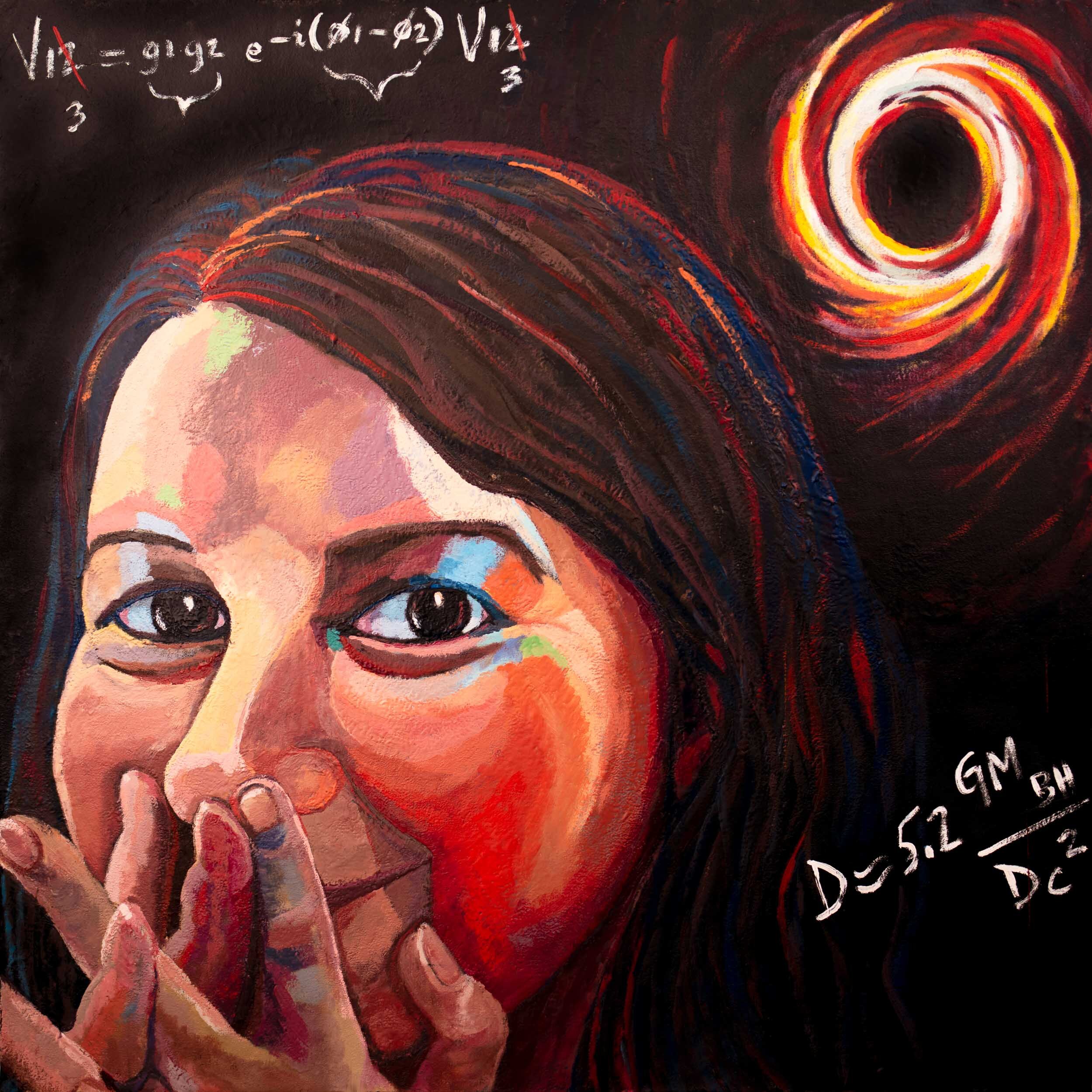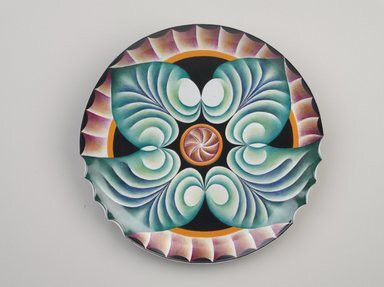Hypatia’s Joy
impression of Katie Bouman
Hypatia was an Alexandrian mathematician, astronomer, educator and philosopher of international reputation who was ultimately accused of witchcraft, assassinated and dismembered by an hysterical anti-pagan mob incited by the archbishop.
Dr. Katie Bouman is an American computer scientist and member of the Event Horizon Telescope team that captured the first direct image of a black hole. Katie Bouman led the development of an algorithm known as Continuous High-resolution Image Reconstruction using Patch priors, or CHIRP inspired image validation procedures.
“No one of us could’ve done it alone, it came together because of lots of different people from many backgrounds.”
“I go after problems that excite me. When I started this project, I didn’t know anything about black holes and honestly, it was a risky project, but my heart was in this. I love this project, and I think that that’s what makes it a success. When you get really smart people together, who are super motivated by the problem that they’re working on, I think people will figure out the answers.”
Hypatia of Alexandria
Detail of the death portrait of a wealthy woman, c. 160-170 AD near modern-day Er-Rubayat in the Fayum, public domain via Wikimedia Commons
Hypatia was a mathematician, astronomer, (which at the time was often equated with sorcery), a teacher who “dared” to teach men, and a philosopher of international reputation who lived in Alexandria between 350AD and 415 AD.
Hypatia was a Neoplatonist, a philosophy which posits that everything derives its being from the One, an ultimately conscious yet nonmaterial, non-spacial entity, the pure ideal of all that is.
The surviving fragments of Hypatia’s teachings speak of “the eye buried within us,” and a “divine guide.” As the soul journeys toward divinity, this “hidden spark which loves to conceal itself” grows into a flame of knowing. Hypatia’s philosophy was concerned with the “mystery of being,” contemplation of Reality, rising to elevated states of consciousness, and “union with the divine,” the One. [Dzielska, 54-5, 48-50]
Hypatia wrote commentaries on important works in geometry and astronomy with her father, Theon, an astronomer and mathematician, devoted to divination and astrology and the pagan mysteries. Theon wrote commentaries on the books of Orpheus and Hermes Trismegistus and poems to the planets as forces of Moira (destiny). Like her father, Hypatia saw astronomy as the highest science, opening up knowledge of the divine.
Theon and Hypatia worked to reformulate Euclides’ “Elements” a foundational textbook still used in mathematics today. Hypatia charted the celestial bodies and is known to have constructed astrolabes and hydrometers.
Essentially a hand-held model of the universe, an astrolabe enables astronomers to measure the altitude above the horizon of a celestial body, day or night; to identify stars or planets, to determine local latitude given local time (and vice versa), and to survey, or triangulate. A hydrometer enables one to measure the relative density and gravity of liquids.
Mamluk era astrolabe, dated 1282, inv no. 2970, Turkish and Islamic Arts Museum, image via Wikimedia Commons
Hypatia was much admired by the entire city, and by people of all faiths, including many Christians. According to Socrates Scholasticus, Hypatia “far surpassed all the philosophers of her time,” and was greatly respected for her “extraordinary dignity and virtue.”
Hypatia, one of the last great thinkers of ancient Alexandria and one of the first women to study and teach mathematics, astronomy and philosophy. (Bettmann / Corbis)
Speaking out against dogmatism and superstition, she wrote: “To rule by fettering the mind through fear of punishment in another world, is just as base as to use force.” [Partnow, 24]
Unquestionably, Hypatia’s teaching represented a challenge to church doctrine. The apparent destruction of her philosophical books underlines the point. Her mathematical works survived and were popular into the next century.
— Max Dashu, War Against the Pagans; Secret History of the Witches
Her tremendous popularity irked the new theocratic bishop of Alexandria, Cyril, who “was so struck with envy that he immediately began plotting her murder.”
During this time Alexandria was in the midst of a power struggle between Christians, Jews and Pagans over the politics of religious intolerance and domination. Founded by Alexander the Great in 331 B.C., the city of Alexandria had been a centre of culture and learning for the ancient world, with a central museum/library/university/research institution known as the Museum of Alexandria which housed a collection of more than a half-million papyrus scrolls, Turkish, Jewish and Babylonian manuscripts. After a series of civil wars and devastating fires the museum was destroyed.
In 391, the archbishop Theophilus (on orders from the Roman emperor to destroy all pagan temples) tore down the temple of Serapis, which may have housed the last scrolls, and built a church on the site. The last known member of the museum was the mathematician and astronomer Theon—Hypatia’s father, who fought to keep the remaining documents intact.
Theophilus was succeeded 412 by his nephew, Cyril who declared war on pagans and heterodox Christians; and expelled the ancient Jewish community from Alexandria.
Attempting to turn the people against Hypatia by accusing her of sorcery, satanic wiles and witchcraft, Cyril is said to have urged his followers to kill the “pagan philosopher”.
Death of the philosopher Hypatia — image from The History Chicks
Hypatia was subsequently murdered by an hysterical anti-pagan mob.
Socrates Scholasticus wrote that “rash cockbrains” dragged Hypatia from her carriage and into the Caesarion church, where they stripped her naked, tortured and then killed her by tearing off her skin with broken roof tiles and defiled her body by cutting her to pieces. They then hauled her dismembered body to Cinaron and burned it on a pyre.
Her assassins vanished and were never punished. Cyril insisted she had moved to Athens. Later, having destroyed “the last remnants of idolatry in the city”, Cyril was declared a saint.
Hypatia, Charles William Mitchell, 1885, Laing Art Gallery — image via Wikipedia
American Artist Judy Chicago created a place setting for Hypatia in her installation artwork The Dinner Party. This work can be viewed at the Elizabeth A, Sackler Center for Feminist Art in the Brooklyn Museum, Brooklyn, New York.
Judy Chicago (American, born 1939). The Dinner Party, 1974–79. Ceramic, porcelain, textile, 576 × 576 in. (1463 × 1463 cm). Brooklyn Museum; Gift of the Elizabeth A. Sackler Foundation, 2002.10. © Judy Chicago. (Photo: Donald Woodman)
Judy Chicago (American, born 1939). Hypatia Place Setting, 1974-1979.
Plate: Porcelain with overglaze enamel (China paint) and paint,, Runner:51 1/2 x 29 7/8 in. (130.8 x 75.9 cm). Brooklyn Museum, Gift of The Elizabeth A. Sackler Foundation, 2002.10-PS-13. © artist or artist's estate (Photo: Brooklyn Museum, 2002.10-PS-13_plate_PS9.jpg)
Judy Chicago (American, born 1939). Hypatia Place Setting, 1974-1979, Brooklyn Museum
Runner:Cotton/linen base fabric, woven interface support material (horsehair, wool, and linen), cotton twill tape, silk, synthetic gold cord, weft-faced bleached linen tapestry, single-ply wool weft, silk thread, wool thread, rubber rings
Dr. Katie Bouman (born 1989) is an American computer scientist working in the field of imaging. She was a member of the Event Horizon Telescope team that captured the first direct image of a black hole, imaged by the Event Horizon Telescope and published in April 2019.
Dr. Bouman led the development of an algorithm for imaging black holes, known as Continuous High-resolution Image Reconstruction using Patch priors, or CHIRP. CHIRP inspired image validation procedures used in acquiring the first image of a black hole in April 2019. Dr. Bouman played a significant role in the project by verifying images, selecting parameters for filtering images taken by the Event Horizon Telescope and participating in the development of a robust imaging framework that compared the results of different image reconstruction techniques.
Dr. Bouman joined the California Institute of Technology as an assistant professor in June 2019, to work on new systems for computational imaging using computer vision and machine learning.
Her group analyzes the Event Horizon Telescope's images to learn more about general relativity in a strong gravitational field.
The team captured an image of the supermassive black hole and its shadow at the centre of a galaxy known as M87. This is the first direct visual evidence that black holes exist, the researchers said. In the image, a central dark region is encapsulated by a ring of light that looks brighter on one side.
The massive galaxy, called Messier 87 or M87, is near the Virgo galaxy cluster 55 million light-years from Earth. The supermassive black hole has a mass that is 6.5 billion times that of our sun.
“I was in total disbelief. We had developed and tested our algorithms for years on data we thought would mimic that of the Event Horizon Telescope, but still there are always surprises in data. Pressing Go on a computer program I had written and immediately seeing a ring come into focus for the first time was amazing and exhilarating. We had prepared for years, but even so it was too easy! It was an unforgettable moment.”
References
- Hypatia, Ancient Alexandria’s Great Female Scholar, Sarah Zielinski
- https://ordinaryphilosophy.com/2018/03/09/in-memory-of-hypatia-of-alexandria-3/
- https://en.wikipedia.org/wiki/Hypatia
- https://www.cherryhillseminary.org/about/ancestor/
- http://thehistorychicks.com/episode-95-hypatia-of-alexandria/
- https://www.theoracleslibrary.com/2015/01/14/library-alexandria-hypatia/
- The Witch of Agnesi, Kat Eschner
- https://www.smithsonianmag.com/history/hypatia-ancient-alexandrias-great-female-scholar-10942888/
- https://www.smithsonianmag.com/smart-news/witch-agnesi-180963221/
- https://en.wikipedia.org/wiki/Astrolabe









